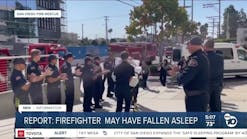Technology Helping Fla. Crews Tackling Wildfires
Source Highlands Today, Sebring, Fla.
July 27--SEBRING -- There are two kinds of fire, according to Stephen Pyne.
"Too much of the wrong kind of fire, not enough of the right kind," said Pyne, who teaches courses on fire and environmental history at Arizona State University.
In America's early days, the wrong kind was started by lightning, locomotives, litterbugs, hunters flushing out game, farmers clearing the land and, of course, Mrs. O'Leary's now-mythical cow in Chicago. It burned forests and cities alike.
"The idea that one might abolish fire seemed quixotic, in fact, dangerous," Pyne wrote in, "History with Fire in Its Eye: An Introduction to Fire in America," published by the National Humanities Center.
"Without fire, most lands were uninhabitable," Pyne wrote. After all, fire was the only practical way for developing nations to cleared the land.
The right kind of fire is used today by farmers and preserve managers, along with the Florida Forest Service, and Highlands Hammock State Park.
"Fire is a tool," said Clinton Howerton, a heavy equipment owner who clears land for ranchers and farmers.
In fact, fire is a must, Howerton contended to a colleague who burned 10 years of growth and complained that the fire got away from him. The friend asked how Howerton and his family managed the 45,000 to 50,000 acres they formerly leased from the Avon Park Bombing Range.
"If you don't burn woods every other year, you'd better get it the third year," Howerton advised. "It will kill the trees if fire gets too hot."
But if pine needles and dead vegetation -- which can grow to nine feet tall -- is burned bi-annually, bark is singed but trees survive.
Modern-day burners learn to manage fires, said Melissa Yunas, wildfire mitigation specialist for the forest service's six-county Okeechobee District.
"Burners must verify that current weather conditions and their burn do not negatively impact smoke-sensitive areas," Yunas said. "Burning is a job that is taken very seriously. Managing the land with fire as a tool is a burner's right by FL Statues 590. The Florida Forest Service ensures the burners are adhering the regulations, and they can restrict authorizations when wildfire activity increases."
The Florida Forest Service educates and certifies burners, who can call or apply online for authorization.
The five-month rainy season, by the way, is also the burning season. Otherwise, the undergrowth gets too high during the seven-month dry season.
Firefighting has become less dangerous, even in the 15 years Joe deBree has been a ranger. He started in 1999, transferred to Sebring in 2000, was the senior ranger in Okeechobee, and is now the new forest area supervisor for Highlands and Glades counties.
The forest service still uses fire towers -- the four in his district are in Sebring, Archbold and Palmdale -- but they're not manned every day during the wet season. "When it starts drying up, we will start staffing them," deBree said, usually with a ranger, but civilians are also hired to call 911 when they see a smoke column.
"The quicker they spot it, the quicker we can get there and contain it," deBree said.
Yunas' statistics show a general decline in Highlands County wildfires: 209 in 2006 -- the worst year in the past 15, 90 in 2008, 58 in 2013. However, the number of acres burned has not declined: 2,548 in 2006, 4,723 in 2009, and 3,088 in 2011.
"Although we are in the wet season, all we need is two weeks without rain," Yunas said.
How do the wrong kind of fires start? Of the 66 so far in 2014, 19 were ignited on purpose, 16 were lightning strikes. The other half were a variety of causes: children playing, trash burning, cigarettes discarded, power lines, recreation equipment and agriculture.
The greatest number of fires this year are authorized burns: 335 to clear noxious weeds and plants from pastures, 69 for range management, 606 for citrus management, 12 for land clearing.
"Fire helps everyone," Howerton said, even foraging wildlife. "A quail will spend more energy digging under the brush and the pine needles than he'll get from the seed."
Years ago, fires got a lot bigger and went unnoticed longer.
That's why a Forest Service airplane pilot, Sanne Esque, patrols after thunderstorms. "If she spots smoke, she'll call and confirm whether there was an authorized burn," deBree said.
That's the downside of the rainy season, deBree said. "We're getting a lot of lighting strikes.
Both deBree and Esque make firefighting safer.
"A lot of technology is being put into place," deBree said. Among the newest: asset tracking software for the laptop in his supervisor's vehicle.
"All the fire equipment have little transponders," deBree said. "Once they turn on the key, I can see them on the laptop."
Most wildfires happen deep in the woods, deBree said. Firefighters and their equipment are easily lost in the smoke.
But with his laptop, "I can see things on the map ahead of them. I can tell them a half-mile away if there's open pasture, or a large canal. We can change our tactics. We can push the fire into a natural firebreak."
Even 15 years ago, dozer crews worked in open-cab tractors. "You just had a bandanna around your face. We had metal cages, but those embers are flying toward you. They'll go right through the cage."
Modern equipment is sealed from exterior smoke, climate-controlled, with special smoke filters. "So they're not inhaling it," deBree said.
On the radio, Esque informs the bulldozer crews below what she sees below, whether a brush truck is headed down a blind alley, or where a water truck can find a canal or lake.
"After the action," deBree said, "we can talk about what went wrong, how to do it better. And when the technology gets better, it's going to help even more."
863-386-5828
Copyright 2014 - Highlands Today, Sebring, Fla.





